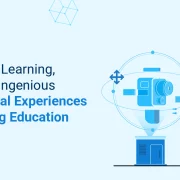
Learn How to Make Your University Efficient with Cloud-Based Solutions
Summary
This blog discusses how cloud solutions help university registrars optimize resources, secure data, reduce IT load, and support research, virtual learning, and disaster recovery.
Higher education institutions are increasingly embracing cloud-based solutions to meet new operational requirements efficiently. This is because cloud solutions for university registrars enable better optimization of campus resources, reliable infrastructure services, a reduction in the load on the IT infrastructure, enhanced flexibility, and better data security.
Cloud services have transformed how universities manage their systems, allowing scalable, cost-efficient solutions for improved access and collaboration. This strategic shift meets current demands and positions universities for competitiveness in the digital age.
Let us learn more about the benefits of using cloud-based solutions and best practices to enhance university administrative and infrastructure services.
Table of Contents:
- Relevance of Cloud-Based Solutions for University Registrars
- Challenges in Securing Sensitive Data of Universities
- Best Practices for Securing Data Management and Administrative Services Using Cloud-Based Solutions
- Benefits of Cloud Solutions to Students and Faculty
- Speeds Up Academic Research
- Accessibility of Educational Resources
- Empower Virtual Learning
- Job Market Skill-Equipped Students
- Disaster Recovery and Backup
- Faster Implementation of Innovations in Data Security
- Automated Enrollment Management
- Mobile Friendly User Interfaces
- Customizable Reports and Dashboards
- Scheduling and Course Management
- Conclusion
Relevance of Cloud-Based Solutions for University Registrars
The global Cloud Computing in Higher Education market is predicted to reach $8,779.1 million by the year 2027. Furthermore, according to research in 2024 by the Wasabi Global Cloud Storage Index, 95% of educational institutions will increase the data stored in the public cloud.
Such systems are gaining popularity as they lower the cost of operations and thus make it possible for universities to scale up, as the number of students increases.
Cloud solutions allow universities to update their tech stack, streamline administrative workflows, and reduce long-term costs. The challenge any university faces is the security of sensitive data, such as student records and research, from cybersecurity threats.
University registrars must protect against data breaches and insider threats and ensure privacy regulations. Cloud-managed services accelerate modernization in higher education.
Also Read: Achieving Educational Fairness with a Web Accessibility Consultant: Hurix Digital’s Approach
Challenges in Securing Sensitive Data of Universities
Here are some key challenges that university registrars and heads of educational infrastructure services face:
1. Data Privacy
Colleges and universities are supposed to manage a large volume of sensitive data, which includes students’ records, employee data, and research-related information.
Institutions need to implement effective security practices that ensure the privacy and confidentiality of student and staff information. Hence, universities should constantly monitor compliance.
2. Data Breaches
Data breaches remain one of the significant threats to universities due to the increased sophistication of cybercriminals.
Cloud systems should be maintained with regular security updates, information encryption, and intrusion detection.
3. Insider Threats
While external threats are important, insider threats can also pose a problem in data security. These might come internally from students, faculty, or staff who may try to compromise sensitive information.
Universities must ensure tight access control and that users are given only the access necessary to perform their functions.
4. Service Provider Risks
Most universities store data using a third-party cloud service. They should stringently screen selected providers to ensure security is one of the better options.
Best Practices for Securing Data Management and Administrative Services Using Cloud-Based Solutions
Following are best practices related to cloud-based solutions that universities can follow:
1. Strong Authentication and Access Controls
Strong mechanisms can be used to authenticate users at different levels. A proper login mechanism also provides security and restricts unauthorized access to confidential data.
Access should also be role-based, and permissions should be provided using fine-grained access control, which restricts the user’s view and access to data according to an individual task.
2. Data Encryption
Data encryption should use strong algorithms and secure encryption keys. These keys ensure that only authorized parties can access the information, providing an additional layer of security.
3. Regular Security Audits
It is very important to conduct periodic security audits on the cloud infrastructure services. It should target the internal systems of the university along with the external infrastructure. Regular assessment allows an institution to fix the potential security gaps before those can be misused.
4. Training and Awareness
It becomes important to protect the sensitive data of higher educational institutions by educating employees and students on security practices. Some of the areas where training programs should focus include recognizing phishing attempts, establishing strong passwords, and reporting suspicious activities.
5. Incident Response Plan
A well-defined incident response plan ensures that, upon the occurrence of a security breach, the reaction scope is addressed with speed and efficiency. For such planning, practice, and updating should be done on a routine basis to make the university prepared for all sorts of threats.
Benefits of Cloud Solutions to Students and Faculty
Considering the global applicability of technology, cloud-based solutions have become pivotal for universities. Here are some ways in which cloud solutions can benefit all stakeholders:
1. Speeds Up Academic Research
Due to the cloud, researchers can effectively analyze large volumes of data and perform heavy-duty calculations. This decreases data processing times and identifies additional time for conducting the research, therefore accelerating innovation.
Cloud data management and storage capacity promote collaboration, as research teams can easily share their information with their peers around the world.
2. Accessibility of Educational Resources
Cloud-based solutions make digital resources much more accessible to students and faculty, making teaching and learning easier. With everything online, less reliance on physical materials would reduce paper waste and ultimately save money.
3. Empower Virtual Learning
Cloud solutions give institutions the ability to offer courses remotely and on-demand. Cloud-managed services and platforms are fully online instructional, allowing students flexibility in studying at their convenience, whether it is due to balancing work, personal responsibilities, or geographical limitations.
This flexibility is essential for institutions that want to meet the ever-increasing demand for online and hybrid learning. Cloud solutions enable educational institutions to keep the curriculum materials updated. Further, integrating learning environments in the cloud allows students to practice with real state-of-the-art tools and technology.
4. Job Market Skill-Equipped Students
Most organizations have growing skill gaps in certain areas, such as cloud computing and cybersecurity. Cloud-based solutions used in universities offer students opportunities by teaching them in-demand skills that are valuable in the job market.
5. Disaster Recovery and Backup
Cloud solutions boast excellent disaster recovery and backup against the failure of systems or loss of data. Institutions can depend on automatic backups and redundant cloud infrastructures to rapidly bring back their data and hence assure minimal downtime. This ability is critical in sustaining uninterruptible operations and securing sensitive information.
6. Faster Implementation of Innovations in Data Security
Universities benefit from frequent updates and new feature releases. Updates with enhanced security, better performance, and new features are also very frequently put out by cloud service vendors. Here are some of the key data management security systems that universities can implement:
- Utilize multi-factor authentication along with role-based access controls so that sensitive data is accessible to only authorized users.
- Data must be encrypted both in rest and in transit using robust encryption algorithms.
- Follow best practices to recognize phishing attacks, use passwords safely, and report suspicious activities.
7. Automated Enrollment Management
Cloud-based solutions help with enrollment management. Students can easily enroll in courses, manage their class schedules, and edit information in their profiles. Additionally, automation reduces the administrative burden and significantly reduces manual errors.
8. Mobile Friendly User Interfaces
Many of the cloud solutions have been planned for mobile access so that even on the go, the user can access the platform. The intuitive interface further reduces the learning curve and enhances data usage for students and staff.
9. Customizable Reports and Dashboards
Customized reports can be generated with visual dashboards by administrators and university registrars to track enrollment trends, retention rates, and academic performance. These further assist data-driven decisions.
10. Scheduling and Course Management
Cloud solutions ease the process of creating course schedules, classroom assignments, infrastructure services, and space utilization. In such a platform, institutions are allowed to manage faculty workload and streamline the process of creating course modules.
Cloud-based registrar solutions can be integrated with existing learning management systems (LMSs), which allows information to be exchanged between academics and administration.
Also Read: Prioritizing Affordability, Flexibility, and Accessibility in Higher Education
Conclusion
Cloud-based solutions offer efficiency, data accuracy, and secure operations to higher education institutions. As data is available in real time, administrative and data management processes are facilitated. The costs of long-term maintenance will decrease, and such technologies will keep universities competitive and responsive.
Partner with experts at Hurix Digital and understand the relevance of cloud solutions. University registrars now have the leverage to use such elite platforms to enhance the institution’s data management and infrastructure services.
Get in touch with us today to get started!

Senior Vice President – Business Development
Over 25 years of experience in the edtech and workforce learning industry with strong skills in Business Development, Customer Relationship Management (CRM) and Strategy.







